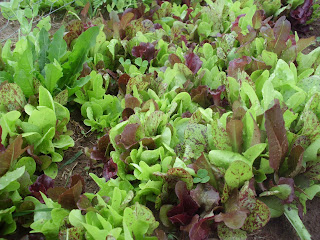Over the years, I have dabbled a bit in other companion planting pairs. It turns out, corn and beans like each other as well. Many of your herbs and flowering plants benefit your fruits and veggies. Lemon balm, rosemary and basil are three herbs that have a glorious scent when touched or the wind blows. It turns out, bugs don't appreciate those beautiful scents as much as us. I have even torn the leaves of lemon balm and scattered them in my squash to chase away the bugs, and it worked!
Marigolds are not the only flower that chases the bugs away from you garden either (by the way marigolds chase away the bad bugs above and under the soil), nasturtiums, yarrow, angelica, chamomile and morning glory lure beneficial insects and help to control the bad bugs.
As I have mentioned in my "Not so ugly truth about weeds" post, weeds can also be beneficial. Dandelions and clover have deep root systems that bring nutrients up to the shallow root plants like corn and radishes. No, you don't want your radish patch smothered in clover, but one here and there is great. I have also always used grass and weeds to make living paths between my rows. It is not good to walk on the soil that has your veggies growing in. Walking on bare soil compacts it. Planning your garden to have strips of grass for walking and working protects your soil from compaction and erosion.
When the weeds and grass grow up a bit, just mow or weed eat it down, and voila, you have another benefit, a bit of green mulch to feed your veggies.
I have always played around a little with companion planting and I have always lived in a small city lot, so companion planting gave the added benefit of fitting more produce into smaller spaces. Despite the small space, I have always had a harvest, even in the super dry and hot summers.
Now that I have moved out to the country, I have an entire 5 acres to spread out my garden, but instead I have chosen to fully embrace companion planting.
Not only will I reap the benefits of added nutrients and insect lures/repellents, but the plants that I have placed together will grow in blocks rather than rows. Planting companion plants closely together, like you would flowers in a flower garden, leave less exposed soil, so unwanted weeds will not grow up between your plants.
If you already have your garden in, never fear, I bet you have a little room to squeeze a few beneficial plants in here and there.
Here is a list of things that love each other:
Tomatoes, Basil, Onions
Onions, Carrots
Horseradish, Potatoes
Radishes, Nasturtiums, Cucumbers
Cilantro, Spinach
Corn, Greenbeans
Corn, Squash
Spinach, Lettuce, Peas
Tomatoes, Parsley, Basil, Asparagus
Nasturtiums, Squash
Onions & Garlic are good for Fruit Trees and Night Shades (tomatoes, eggplant, potatoes)
Beans are good for Beets, Turnips and Onions
Borage is good for Strawberries and Cucumbers
Marigolds are good for Tomatoes, Asparagus and Squash
Geranium is good for Tomatoes, Grapes and Roses
My favorite benefit of companion planting is how lush and beautiful the garden looks because of the variety and health this method provides. Try it out for yourself and see how your harvest benefits! ~Rebecca









No comments:
Post a Comment